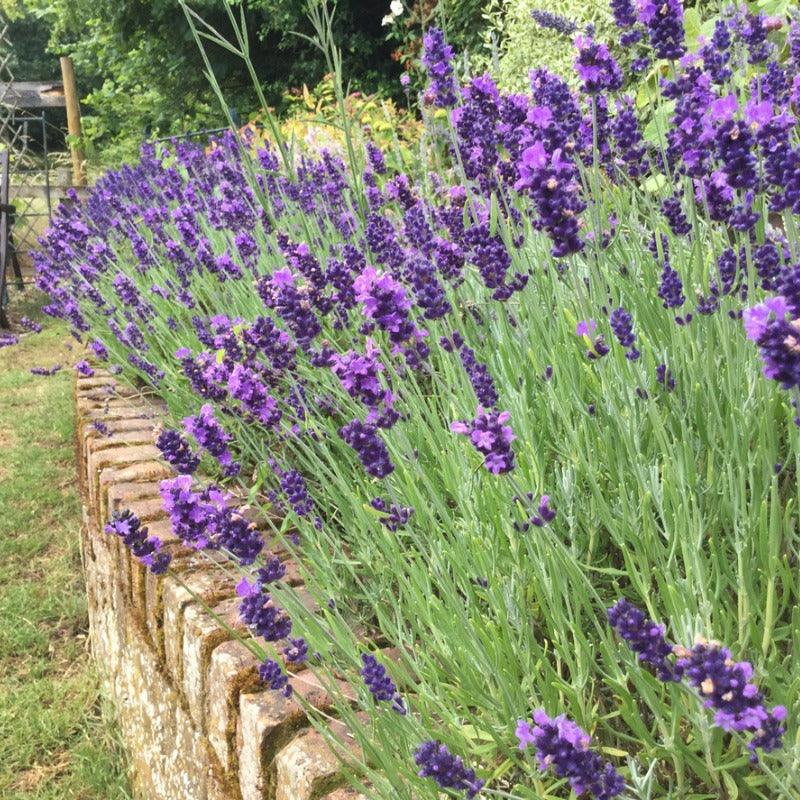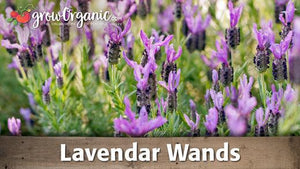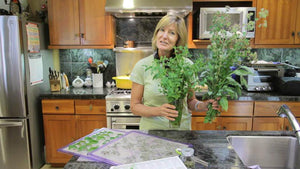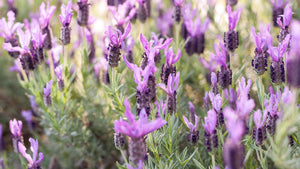Item Number: PV211
Hidcote Lavender (1 Gallon)
Deep purple-blue flowers with exquisite scent
Hidcote Lavender is a cultivar of Lavandula angustifolia, commonly referred to as English Lavender. It is characterized by its petite stature, growing only 18-24 inches tall and wide, making it ideal for small gardens, container plantings, or as edging along paths and borders. The plant is renowned for its intense, deep purple-blue flowers which emit a delightful fragrance, attracting bees and butterflies while deterring deer and rabbits—an advantageous feature for gardeners seeking natural pest control.
Growing Conditions
Light Requirements: Hidcote Lavender thrives in full sun, requiring at least 6-8 hours of direct sunlight daily. Placing it in a sunny spot ensures robust growth and abundant blooms during the summer months.
Soil Preferences: This variety prefers well-drained, dry to medium moisture soils. It is crucial to avoid waterlogged conditions as Lavender plants are susceptible to root rot in overly wet soils. Sandy or gravelly soils with good drainage are ideal, mimicking the arid environments where Lavender naturally thrives.
Hardiness Zones: Hidcote Lavender is suited for USDA Hardiness Zones 5 through 9, encompassing a wide range of climates from moderately cold winters to hot, humid summers.
Watering Needs: Once established, Hidcote Lavender is remarkably drought-tolerant. During the first growing season, however, regular watering is essential to help the roots establish. Once the plant is mature, it generally thrives on natural rainfall and requires minimal supplemental watering except during prolonged dry spells.
Maintenance
Pruning: Regular pruning is beneficial to maintain the compact shape and encourage new growth. Prune Hidcote Lavender immediately after flowering, cutting back spent blooms and lightly shaping the plant. This practice also helps improve air circulation around the plant, reducing the risk of disease.
Fertilization: Lavender plants generally do not require heavy fertilization. In fact, excessive nitrogen can lead to lush foliage at the expense of flowers. A light application of balanced fertilizer in early spring or a top dressing of compost can suffice to support healthy growth.
Winter Care: In colder climates, a layer of mulch around the base of the plant can provide protection during winter months. Avoid heavy mulching directly around the stems to prevent moisture retention.
Uses in the Garden
Hidcote Lavender offers versatile landscaping options:
Borders and Edging: Its compact size and neat growth habit make it ideal for defining borders or edging garden beds.
Containers: Well-suited for container plantings, Hidcote Lavender adds fragrance and color to patios, balconies, and small urban spaces.
Rock Gardens: Thriving in dry, rocky soils, Hidcote Lavender enhances the beauty of rock gardens with its vibrant blooms and aromatic foliage.
Cutting and Drying: The flowers are excellent for fresh or dried bouquets, retaining their fragrance and color long after harvesting.
Conclusion
Hidcote Lavender, with its compact size, fragrant blooms, and low maintenance requirements, is a quintessential choice for both novice and experienced gardeners alike. Its adaptability to various growing conditions, from dry soils to full sun exposure, makes it a valuable addition to gardens across USDA Zones 5 to 9. Whether used in mass plantings, container gardens, or as part of a wildlife-friendly landscape, Hidcote Lavender continues to charm with its beauty and functional benefits. Consider incorporating this resilient and aromatic herb into your garden to enjoy its many advantages, from attracting pollinators to providing aromatic bouquets for your home.
Visit our Berry, Vine & Crowns Characteristics Chart to compare growing characteristics for all our berries, vines, and crowns.



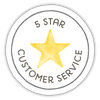
Check Your Zone Compatibility:
Compatible with your zone.
Growing Zone for

Our Guarantee To You
Since 1976, we've served our customers at every stage of growing. Please contact us at any time. We are happy to support and assist you.
Shipping Information
Shipping Information
Shipping Weight: 5.0 lb
Dimensions: 5.5"L x 5.5"W x 20.0"H
Features
Features
- Container Compatible
- Drought Tolerant
- Edible Flower
- Fragrant
- Long-Lived
- Potted
Characteristics
Characteristics
Planting & Care
Planting & Care
Soil and Water: Plants need good drainage and moderate soil fertility. Once established only needs moderate water.
Planting and Growing: Plant Hidcote Lavender starts outdoors after the danger of frost has passed and soil temperatures have warmed to at least 60°F (10°C). Space plants 8-12 inches apart in rows.
Harvesting & Storage: Plants will bloom moderately in the first year and come into full bloom the second year. Plant can be shaped after the bloom to keep compact. Remove flowers and use either fresh or dried.
Useful Information
Useful Information
Guarantee
Guarantee
We guarantee the perishable items we sell to be in good, viable condition when we sell them. Perishable items include, but are not limited to, garlic bulbs, flower bulbs, seed potatoes, onion sets & transplants, potted or bare root trees, vegetable crowns, etc. If your perishable item arrives in substandard condition, take photographs and please contact us within 3 days of the purchase date (or delivery date) and we will provide you with a refund of the purchase price (excluding shipping costs), or a replacement. Accordingly, we urge you to open any boxes marked as ""Perishable"" immediately upon receiving them and inspect the shipment thoroughly (do not crack open heads of garlic, we do not accept claims on cracked garlic). Because some perishable items can deteriorate very quickly, we cannot accept any claims beyond the 3-day time frame as it becomes too difficult to determine if these items were delivered in substandard condition, or if they turned into such substandard condition because of having been improperly cared for or stored once delivered.
Share
